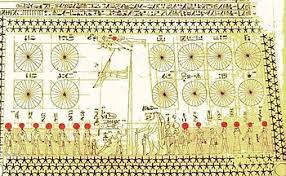Kalendarz Egipski

Kalendarz egipski należy do najstarszych w świecie. Powstał przypuszczalnie w 4241 r. p.n.e. W każdym razie w tym czasie znany był już kalendarz oparty na księżycowej rachubie czasu.
Początkowo dzielił się on na 3 pory (echet, projet i szonu) i 12 miesięcy, liczących po 30 dni. Składał się więc z 360 dni.
Z kalendarzem tym więcej było kłopotu niż pożytku. Na szczęście nieporozumienia wśród bogów sprawiły, że do tak pomyślanego kalendarza doszło 5 dni i kalendarz zbliżył się do rachuby słonecznej. A stało się to tak:
„Bogini Nieba Nut pokochała boga Ziemi — Geba i wyszła potajemnie za niego. Dowiedziawszy się o tym bóg Słońca — Ra — bardzo się rozgniewał. Nut była jego wnuczką, ale on kochał ją bardzo czule… Rzucił klątwę na Nut: »jeśli zechce kiedykolwiek urodzić dziecko — niech nie będzie takiego miesiąca w roku, w którym mogłoby ono przyjść na świat!« Zapłakana Nut, która akurat spodziewała się dziecka, pobiegła do boga mądrości — Tota, aby jej pomógł. Tot udał się do boga Księżyca — Chonsu — i zaproponował, by zagrał z nim w kości. Tot wygrał od Chonsu 5 dni, które ten miał schowane na czarną godzinę. I tak oto bóg Tot dodał do roku 5 dni, w ciągu których bogini Nut urodziła wszystkie swe dzieci. Pierwszego dnia urodził się Ozyrys — bóg zaświatów, patron zmarłych, drugiego — Horus Starszy, bóg nieba, który został potem pierwszym faraonem Egiptu, trzeciego — Set, bóg wojny, czwartego — Izyda, bogini Ziemi, piątego wreszcie — Neftyda, bogini miłości”.
Oczywiście, była to reforma, którą kapłani uzasadnili „racjami boskimi”. Dzięki niej kalendarz egipski liczył już 365 dni i bardzo zbliżył się do słonecznej rachuby czasu.
Dodatkowych 5 dni tego kalendarza nie miało jednak nazwy i uważane były za feralne. Były to dni pokutne, w których kapłani nakazywali modły, mające zabezpieczyć przed nieszczęściami.
Początkowo również miesiące nie miały nazw. Numerowano je w ramach okresów. Pisano: pierwszy (miesiąc) echet (okresu echet), drugi szonu, trzeci projet itp. (okresy miały po 4 miesiące). Miesiące dzieliły się na dekady (miesiąc miał ich 3, okres — 12, rok — 36). Z czasem miesiące otrzymały nazwy. Nazywano je (począwszy od pierwszego miesiąca pierwszego okresu):
| Echet | Szonu | Projet |
| Thoth | Tybi | Pachon |
| Faofi | Mechejr | Pauni |
| Hathyr | Famenoth | Epeif |
| Chojak | Farmuthi | Mesore |
I ten kalendarz — choć ulepszony przez boga Tota — nie należał do doskonałych. 365-dniowy kalendarzowy rok egipski był przecież krótszy o 0,2422 dnia od astronomicznego roku zwrotnikowego. Początek roku — obchodzony zawsze w dniu rozpoczynającego się wylewu Nilu — cofał się coraz bardziej: co 4 lata o 1 dzień, w ciągu 40 lat — o 10, w ciągu 400 —o 100 itd. W tej sytuacji doszło w końcu do tego, że nawet pory roku nie występowały we właściwym czasie. Ale kapłani zorientowali się dość szybko w czym rzecz.
Przypuszczalnie już w 4241 r. p.n.e. (jak chcą niektórzy — w 2781, a nawet w 1321 r. p.n.e.) obliczyli dość dokładnie długość roku (wynosiła ona 365,25 dnia, a więc bardzo niewiele różniła się od rzeczywistej). Dokonali tego na podstawie obserwacji ruchu gwiazdy Sopdet-Syriusza.
Obliczyli też, że ponowne wyrównanie kalendarzowej rachuby czasu z astronomiczną nastąpi po 1460 latach, odpowiadających 1461 latom wyznaczanym przez gwiazdę Sopdet (czas ten nazywano „okresem Sopdet”, lub — z grecka — „okresem Sotisa”).
Znaleźli również sposób zaradzenia temu ciągłemu „wędrowaniu” kalendarzowego początku roku: wystarczyło co 4 lata wprowadzić rok przestępny, zwiększając długość roku kalendarzowego o 1 dzień. Nie wprowadzili jednak zmian do kalendarza. Dzieło bogów było przecież święte i nikt ze śmiertelnych nie mógł go zmienić.
Dopiero po śmierci Aleksandra Wielkiego, gdy wpływy kapłanów w państwie zostały ograniczone, zaistniały warunki do reformy. Podjął ją w 238 r. p.n.e. Ptolemeusz III Eurgetes. Dekretem z Kanapos polecił on co 4 lata dorzucać do 360 dni nie 5 (jak to czyniono od czasu, gdy bóg Tot wygrał je od Chonsu), lecz 6 dni. Odtąd też lata sopdetowe (odpowiadające mniej więcej zwrotnikowym) zaczęły pokrywać się z latami kalendarzowymi.
Lud egipski — przyzwyczajony od tysiącleci do , „świętego kalendarza” — nie był jednak reformą zachwycony. Powstała paradoksalna sytuacja: oficjalnie obowiązywał kalendarz Ptolemeusza III, ale powszechnie posługiwano się kalendarzem boga Tota. Chaos, jaki w związku z tym zapanował, łatwo sobie wyobrazić. Opanował go dopiero cesarz August rozporządzeniem z 30 r. p.n.e., wprowadzając kalendarz juliański, nazywany w Egipcie „aleksandryjskim” lub „macedońskim”. W zasadzie nie różnił się on od kalendarza Ptolemeusza III, innowacją był jednak rok przestępny (występujący co 4 lata), a także początek roku, występujący w dwu terminach: w pierwszym dniu miesiąca Thoth, a więc — w dniu heliakalnego wschodu gwiazdy Sopdet, czyli Syriusza, pokrywającym się mniej więcej z wylewem Nilu (19—21 VII), i 1 stycznia, a więc zgodnie z „rzymskim kalendarzem” obowiązującym w całym imperium. Ten pierwszy, „święty”, obchodzony był bardzo uroczyście.
A data początkowa egipskiej rachuby czasu? Egipcjanie nie posługiwali się erą. Kolejne lata liczyli według panowania faraonów, a obliczenia te rozpoczynali od chwili wstąpienia na tron każdego nowego władcy. Na szczęście udało się historykom ustalić kolejność władców i czas ich panowania. Korelacja chronologii egipskiej z naszą nie nastręcza więc poważniejszych trudności.
